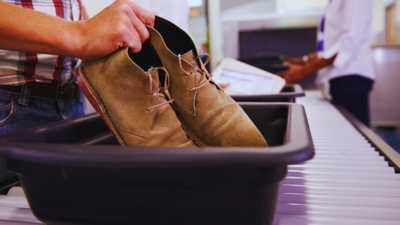The United States has officially ended the long-standing requirement to remove shoes during airport security checks. Homeland Security Secretary Kristi Noem announced this recently that the Transportation Security Administration (TSA) would no longer require passengers to take off their footwear at checkpoints, a policy that had been in place since 2006.“I think most Americans will be very excited to see they will be able to keep their shoes on, and it will be a much more streamlined process,” said Noem, speaking at a press conference at Ronald Reagan Washington National Airport.
Why the shoe rule was introduced
The “shoe rule” traces its roots back to a chilling incident in December 2001, when Richard Reid, later dubbed the “shoe bomber,” attempted to blow up an American Airlines flight from Paris to Miami. He tried to detonate explosives hidden in his shoes mid-flight. Thanks to alert passengers and crew, the attack was foiled, and the aircraft landed safely in Boston.Although the attack failed, it prompted the TSA to enforce stricter screening protocols. By 2006, removing shoes became mandatory for all passengers aged 12 to 75 as part of the screening process. Shoes were scanned alongside carry-on items to detect concealed explosives.Read more: What’s the difference between a passport and a visa? Explained simply
What’s changing now?

With advancements in security technology and the implementation of a more “layered” approach to threat detection, the TSA believes the rule is no longer necessary for all passengers. “Our security technology has changed dramatically. It’s evolved,” said Noem. “We have a multilayered, whole-of-government approach now.”The change, which takes effect immediately, applies across all U.S. airports. However, authorities clarified that passengers may still be asked to remove shoes on a case-by-case basis if additional screening is deemed necessary.
Will it help travellers?
The most immediate benefit is a faster and more convenient screening process. For years, removing shoes was seen as one of the most annoying, and time-consuming, parts of airport security. Passengers had to juggle their carry-ons, personal items, and sometimes children, while also struggling to take off and put on shoes in crowded lines.Eliminating this step, especially for families, elderly passengers, and those with disabilities, will significantly ease the stress during airport security. The new policy is expected to reduce wait times, improve passenger flow, and make the overall experience less invasive.
TSA PreCheck still offers advantages
While the no-shoes rule has been lifted for standard screenings, TSA PreCheck, a trusted traveller programme that allows expedited screening for pre-approved passengers, continues to offer other perks. Members don’t have to remove belts, light jackets, or laptops from their bags.PreCheck costs around $80 for five years and remains the preferred option for frequent flyers. For now, regular passengers will still have to place items like laptops, liquids, and coats on the conveyor belt for scanning.Read more: “Welcome to Afghanistan”: Viral tourism video sparks debate over Taliban-era travel
What’s next in airport screening?
Secretary Noem hinted at broader reforms on the horizon. “TSA plans to review other rules and procedures to see how airport screenings can be simplified and expedited,” she said. The agency is experimenting with separate lanes for military personnel and families with young children and is expected to pilot additional changes in the coming months.In recent years, TSA has also introduced facial recognition technology and Real ID requirements as part of its effort to modernise passenger identification and boost security without causing unnecessary friction.While removing shoes may seem like a minor issue, it has long been symbolic of the post-9/11 security landscape. The end of this rule marks a subtle shift toward a more passenger-friendly experience, one that balances efficiency with vigilance.
